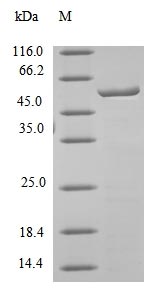The process of producing recombinant mouse Carboxylesterase 1C (Ces1c) involves several key steps. First, the target gene coding for the 19-550aa of the mouse Ces1c is obtained. This gene is cloned into an expression vector, designed to carry the gene into a host cell. The vector is transformed into E. coli cells, where the recombinant protein is expressed. The protein is collected from the cell lysate and purified using affinity chromatography. Finally, the recombinant Ces1c protein's purity is measured by SDS-PAGE, reaching up to 90%.
Mouse Ces1c is an enzyme found in mice that plays a crucial role in the metabolism and stability of various compounds, particularly linkers in drug delivery systems. This enzyme, absent in humans, monkeys, and dogs, has been identified as responsible for the rapid degradation of certain linkers in mouse plasma, impacting the pharmacokinetics of drugs [1][2]. Studies have highlighted the significance of Ces1c in cleaving linkers such as valine-citrulline-paminocarbamate (VC-PABC) in mouse plasma, leading to linker instability [3][4]. Ces1c has been associated with the hydrolysis of linkers like Val-containing peptide linkers in mouse plasma, affecting the stability of drug conjugates [5][6]. Furthermore, Ces1c has been linked to the instability of specific linkers in mouse plasma, complicating the interpretation of pharmacokinetic and pharmacodynamic studies in mice [7]. The presence of Ces1c in mice has been shown to influence the stability and efficacy of drug delivery systems, particularly antibody-drug conjugates (ADCs), by cleaving susceptible linkers like Val-Cit in mouse plasma [8][9].
References:
[1] W. Zhang, Pharmacokinetics of panobinostat: interspecies difference in metabolic stability, Journal of Pharmacology and Experimental Therapeutics, vol. 389, no. 1, p. 96-105, 2024. https://doi.org/10.1124/jpet.123.002051
[2] R. Ubink, E. Dirksen, M. Rouwette, E. Bos, I. Janssen, D. Egginget al., Unraveling the interaction between carboxylesterase 1c and the antibody–drug conjugate syd985: improved translational pk/pd by using ces1c knockout mice, Molecular Cancer Therapeutics, vol. 17, no. 11, p. 2389-2398, 2018. https://doi.org/10.1158/1535-7163.mct-18-0329
[3] M. Dorywalska, R. Dushin, L. Moine, S. Farias, D. Zhou, T. Navaratnamet al., Molecular basis of valine-citrulline-pabc linker instability in site-specific adcs and its mitigation by linker design, Molecular Cancer Therapeutics, vol. 15, no. 5, p. 958-970, 2016. https://doi.org/10.1158/1535-7163.mct-15-1004
[4] M. Dorywalska, Data from molecular basis of valine-citrulline-pabc linker instability in site-specific adcs and its mitigation by linker design,, 2023. https://doi.org/10.1158/1535-7163.c.6538915
[5] Z. Su, D. Xiao, F. Xie, L. Liu, Y. Wang, S. Fanet al., Antibody–drug conjugates: recent advances in linker chemistry, Acta Pharmaceutica Sinica B, vol. 11, no. 12, p. 3889-3907, 2021. https://doi.org/10.1016/j.apsb.2021.03.042
[6] A. Pal, W. Albusairi, F. Liu, M. Tuhin, M. Miller, D. Lianget al., Hydrophilic small molecules that harness transthyretin to enhance the safety and efficacy of targeted chemotherapeutic agents, Molecular Pharmaceutics, vol. 16, no. 7, p. 3237-3252, 2019. https://doi.org/10.1021/acs.molpharmaceut.9b00432
[7] N. Loos, Interplay of ritonavir-boosted oral cabazitaxel with the organic anion-transporting polypeptide (oatp) uptake transporters and carboxylesterase 1 in mice, Molecular Pharmaceutics, vol. 21, no. 4, p. 1952-1964, 2024. https://doi.org/10.1021/acs.molpharmaceut.3c01205
[8] S. Seaman, Z. Zhu, S. Saha, X. Zhang, M. Yang, M. Hiltonet al., Eradication of tumors through simultaneous ablation of cd276/b7-h3-positive tumor cells and tumor vasculature, Cancer Cell, vol. 31, no. 4, p. 501-515.e8, 2017. https://doi.org/10.1016/j.ccell.2017.03.005
[9] N. Ashman, J. Bargh, & D. Spring, Non-internalising antibody–drug conjugates, Chemical Society Reviews, vol. 51, no. 22, p. 9182-9202, 2022. https://doi.org/10.1039/d2cs00446a






